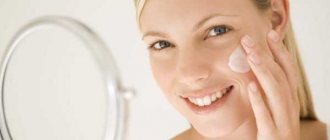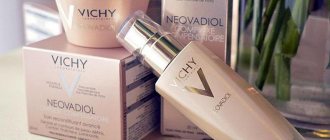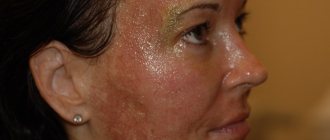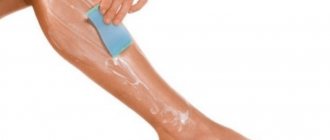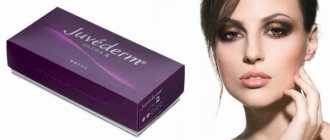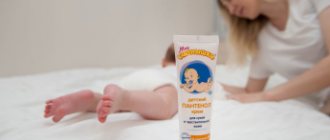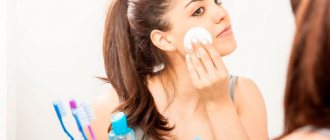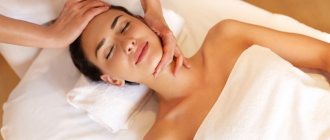At what point does the skin become mature Tips for caring for aging skin Stages of skin care At what age can you take anti-age products? The principle of action of anti-aging products What components should be included in anti-aging cosmetics? Types of anti-aging products How to choose the right anti-aging cosmetics When to start using anti-aging products 20 years 30 years 35 years 45-50 years
The magic cream that erases wrinkles from the face has not yet been invented. But scientists are constantly developing more and more effective anti-aging cosmetics. And it really works, it is only important to choose “your” product and use it regularly in combination with others, including beauty procedures. Then aging will be able to be, if not stopped, then significantly slowed down.
At what point does skin become mature?
Skin that has shown the first signs of aging is considered mature:
- increased dryness;
- decreased firmness and elasticity;
- the appearance of facial and deep wrinkles;
- the appearance of age spots, visible capillaries;
- the appearance of bags under the eyes.
Everything is very individual, but this happens around 35-40 years old. It is recommended to introduce anti-aging components into care no earlier than 30-35 years. But the environment and stress greatly affect our appearance, so signs of aging can be seen at an earlier age.
Tips for caring for aging skin
Skin is considered mature at the age of 35. If you do not want to look older than the mark in your passport, then you should take care of the condition of the epidermis. For this it is important:
- Visit a cosmetologist and do not neglect salon procedures.
- Protect your skin from UV rays daily. And not only on summer days, but at any time of the year. Science has proven that sun exposure is the main cause of premature aging. They injure the surface of the skin, making it rough, inelastic, causing wrinkles, spider veins and pigmentation. Therefore, applying sun cream to your skin should become a daily ritual.
- Get rid of bad habits. This is especially true for smoking. Tobacco smoke not only contains a large number of mutagens and carcinogens, but also has a destructive effect on collagen and elastin, contributing to the appearance of purse-string wrinkles.
- Normalize sleep. When we deprive ourselves of a full 8-hour sleep, the exfoliation of the top layer of skin is disrupted, regenerative processes and the synthesis of necessary substances are inhibited.
- Eat properly. Impact on the skin from the inside always brings greater effect, so do not forget to include fish, seafood, lean meat, nuts, fruits, vegetables, and fresh herbs in your diet.
- Maintain drinking regime. Water is the main tool for hydration, removing toxins and maintaining skin elasticity.
- Get an annual physical exam. Often wrinkles and age spots are the result of endocrine, digestive, and hormonal problems.
- Don't squeeze pimples. Acne can also appear in adults for a number of reasons. Mechanical impact on the pimple will lead to skin injury, and then to the appearance of scars and age spots.
- Move as much as possible. Sport has a beneficial effect on your overall appearance, and to maintain youthful skin it performs a number of important functions: it speeds up metabolism, improves blood microcirculation, saturates cells with oxygen, and removes toxins through sweat.
Skin care steps
Anti-aging care is not complicated. However, products for it should have the most effective composition, aimed at both general hydration and solving local problems.
Stage 1 – make-up removal.
You can remove decorative cosmetics and impurities using hydrophilic oil, micellar water, and makeup remover milk. To avoid skin irritation, choose alcohol-free formulas.
Stage 2 – cleansing.
Delicacy and tenderness are important here. Choose products labeled “for sensitive skin.”
Stage 3 – toning.
This step will complete the cleansing, enrich the skin with plant extracts and prepare it for the application of basic care.
Stage 4 – moisturize the entire face (except for the area around the eyes).
This will give the skin softness, elasticity, saturate it with moisture and activate metabolic processes. During the day, you can use a cream with a lighter texture, and in the evening use a restorative agent for intense oxygenation of the skin.
Stage 5 – moisturizing the area around the eyes.
The cream will specifically act to reduce the depth of wrinkles in this area and prevent the appearance of dark circles and bags.
Stage 6 – application of antioxidant serum with vitamin C.
Vitamin C is a treasure trove of benefits for the skin. It helps reduce pigmentation, reduces transepidermal moisture loss, prevents thickening of the stratum corneum, evens out and brightens the complexion. Its content in serums is much higher than in creams, so the effect will not be long in coming.
Also use moisturizing masks and exfoliators 1-2 times a week.
It is important to treat home care with discipline and awareness. If you don't follow these simple steps, your skin will soon become tight, dehydrated, and wrinkled.
The cosmetic market is rich in various brands and anti-aging products. However, when choosing care, it is important to pay attention to the following components in the composition:
- hyaluronic acid;
- thermal water;
- vitamins A, C, E, B3 (niacinamide);
- proxilan;
- oils and extracts of natural origin;
- peptides;
- collagen;
- Coenzyme Q10;
- fruit acids;
- snail mucin.
At what age can you take anti-age products?
Active aging of the body (including facial skin) begins at 35-40 years. This does not mean that wrinkles, pigmentation and other signs will appear immediately at this age. But from a young age you need to take a closer look at products containing antioxidants and substances that prevent the loss of hyaluronic acid. It is part of connective tissue and regulates the water balance of the skin. Later, you can add cosmetics with components that prevent the destruction of elastin, stimulate collagen synthesis, etc.
Features of anti-aging care from 40 to 50 years
At the age of 40-45, the normal course of all processes in skin cells noticeably slows down. However, even at this age you can still look quite youthful if you take care of yourself (without salon hardcore!) and maintain a healthy lifestyle.
- Collagen reserves are decreasing;
- There are more and more wrinkles;
- The oval of the face undergoes gradual deformation;
- The skin becomes noticeably drier than before;
- The level of the female hormone estrogen decreases, which also does not benefit the skin.
Therefore, the rules of anti-aging care will have to change a little.
- It's time to choose really high-quality day and night creams. The daytime one should provide good hydration, the nighttime one should have a rich nutritional composition. Intense hydration is still your priority;
- Actively use cosmetics labeled anti-age. Its composition is selected specifically for the needs of the skin at your age; ordinary cosmetics may no longer be so effective;
- Switch to more concentrated peeling products, light ones are no longer enough. But there’s no need to be harsh: stay at medium concentration;
- It is better to give preference to expensive pharmacy cosmetics. The quality of care products for 40+ is of great importance.
As for skin care after 45 years, new nuances appear here. Hormonal surges become pronounced. Jowls and bags under the eyes are already forming, and the skin is drying out. What to pay attention to in addition to the above:
- Actively use products with ceramides and hyaluronic acid to retain water in cells;
- Lean on peptides;
- Enrich your products with vitamins A and E to nourish the skin and stop oxidation;
- Introduce cosmetics with a whitening effect, since active skin pigmentation begins closer to 50;
- Don't forget about the skin of your neck and décolleté. The same products are suitable for her as for the face. But it is better to purchase separate ones;
- Focus on stimulating your facial muscles. Go to the salon for appropriate procedures: myostimulation, massages. This needs to be done in courses, but on a regular basis. Better - all the time.
The principle of action of anti-aging products
Age-related changes on the skin of the face look like a whole bunch of signs:
- dull color;
- weak elasticity;
- small wrinkles in the corners of the eyes and lips;
- emerging large wrinkles on the forehead, nasolabial folds and in the glabellar triangle;
- pronounced pores;
- dark spots.
All of them appear under the influence of biological processes occurring in the body: the ratio of hormones changes, collagen production decreases, facial expressions increase. These changes are aggravated by unfavorable external factors: poor environment, stress, smoking, drinking alcohol, unbalanced diet.
Anti-aging cosmetics become “external support” for the skin. It replenishes the lack of moisture and helps retain it thanks to the content of hyaluronic acid. Particularly valuable is low-molecular hyaluronic acid, which penetrates the epidermal barrier and moisturizes the skin from the inside.
Collagen and elastin present in the composition are also necessary to support the facial frame. Centella asiatica, growth factors, peptides, succinic and lactic acids help restore blood circulation, which is so necessary for normal tissue nutrition, reduce swelling, and activate the synthesis of your own collagen. Another direction of their action is relieving stress at the cellular level and restoring natural protective functions.
An important task of anti-aging cosmetics is to protect the skin from the sun. Ultraviolet radiation promotes photoaging; under its action, collagen and elastin are destroyed faster, so the presence of a sun protection factor in the chosen product will be a plus.
What components should be included in anti-aging cosmetics?
- Biotin.
Without vitamin H, better known as biotin, healthy and beautiful skin is impossible. Symptoms of a deficiency of this substance are cracks in the corners of the mouth, dry and dehydrated skin, and hair loss. Biotin helps cells achieve their full growth and strengthens the skin. Its natural sources include nuts, eggs, avocado and cauliflower. To achieve the best results, along with using cosmetics with biotin, it is useful to include products with biotin in the menu.
- Alpha lipoic acid.
This “magic” cosmetic ingredient slows down the aging process of the skin and has high calming properties.
- Retinol.
This derivative of vitamin A has gained the reputation of “a fighter for eternal youth.” Retinol “heals” fine wrinkles, erases age spots, improves complexion and increases skin turgor. During the first use of cosmetics with retinol, skin sensitivity reactions are possible - redness and irritation, but they pass very quickly. But if they are not there, this is a reason to be wary - the cream does not work! Avoid forms of vitamin A such as retinyl palmitate and retinyl linoleate - they are not irritating to the skin, but are also less effective.
- Ceramides.
Ceramides help the skin maintain an optimal level of moisture, because it is no secret that with age the skin becomes drier. Since the amount of ceramides decreases as you get older, cosmetics containing them can help prevent dry skin and, as a result, irritation and inflammation.
- Glycolic acid.
Glycolic acid is an excellent exfoliant that gently exfoliates the skin, restoring its youthful colors. Additionally, it stimulates the production of elastin and collagen in the body, reducing visible signs of skin aging. Today it is the most powerful skin moisturizer.
- Coenzyme Q10.
The lack of this substance in a woman’s body jeopardizes the synthesis of two main structural elements of the skin - elastin and collagen. Statistics show that most people over 30 have some degree of CoQ10 deficiency unless they take a CoQ10 supplement.
If your skin quickly loses its elasticity and becomes less elastic, pay attention to the content of this substance in cosmetics and food products. Most of it is found in meat and poultry, peanuts, broccoli and spinach, and tofu. Coenzyme Q10 shows amazing results on the thinnest and most vulnerable area of the skin - the eyelid contour. It protects the periorbital area from harmful UV rays and may help reduce wrinkles at the corners of the eyes.
- Lactic acid.
Research shows that when used in cosmetics, it can increase skin density and thickness, as well as reduce signs of premature aging. Lactic acid also has an amazing ability to attract and retain moisture, so it works as a humectant.
- Vitamins A, C, E and K.
Free radicals, the main culprits of premature skin aging, cannot resist these antioxidants. They reduce inflammation in the body, help cope with the damaging effects of ultraviolet radiation, stimulate the formation of collagen and elastin and, finally, maintain the beauty and health of the skin. “Beauty vitamins” are useful to take both from food and applied to the skin as part of cosmetics.
- Niacinamide.
Many fair-skinned women are looking for an effective and at the same time safe remedy to get rid of pigmentation. This is vitamin B3 - niacinamide.
Lazy skin
What happens if you get carried away and start using anti-aging cosmetics ahead of time? There is an opinion that in this case the skin becomes “lazy”, ceases to maintain the normal rate of metabolism and, as a result, ages even faster. In fact, this is not true, it’s just that even the best anti-aging cosmetics will not provide as much benefit as they could if their use were justified. We draw conclusions: we begin to use “adult” cosmetics when the first real signs of fading appear. To do this, we carefully monitor and monitor the condition of the skin, because starting the fight against aging in time will be more effective.
Types of anti-aging products
You need to take care of aging skin according to a traditional ritual consisting of three steps:
- Cleansing.
- Toning.
- Hydration.
Cleansing cosmetics are necessary to remove not only dirt and sebum particles, but also dead skin cells. In this capacity, soft exfoliating lotions and foams with acids.
Day face cream protects and nourishes the skin, contains microelements, vitamins, antioxidants, stimulates regeneration and natural barrier functions, improves blood circulation. Night cream restores and renews the skin.
The cream around the eyes has a lighter texture, due to which it is well distributed. And the high concentration of active substances has a beneficial effect on thin skin. The main task is to remove circles under the eyes and swelling, smooth out wrinkles.
Depending on the set of active ingredients, the mask moisturizes, nourishes, cleanses or rejuvenates. You should definitely add masks to your anti-aging care 2-3 times a week.
Serums with a light texture contain a very high concentration of active substances, so they work actively and are used with caution.
Problems and methods of solution
Most people evaluate their own kind comprehensively. No one will say “she has elastic skin and a clear oval face,” the description will sound simpler - “she looks young.” Conversely, those around you will not go into detail, finding out why a woman looks middle-aged - because of marionette wrinkles, pronounced nasolabial folds, jowls, pigmentation or noticeable sagging of the epidermis.
Cosmetologists look at faces a little differently. For them, youth is a complex of individual details that create a complete image. An experienced specialist immediately sees what needs to be done to make your face look younger. Some will need to smooth out wrinkles, some will need to give clarity to the oval, and some will need to eliminate pigmentation.
Sometimes one type of procedure is enough to achieve a noticeable anti-aging effect, sometimes a combination of different types of manipulation is required. In any case, the doctor prescribes procedures, taking into account the condition of the skin and existing defects.
- Expression wrinkles, noticeable even with complete relaxation of the face. Botulinum toxin injections come to the rescue. The muscle relaxant relaxes the muscles, relieves tension - and the skin also smoothes out. Toxin injections are sometimes used for prevention, but are especially effective if skin breaks have already formed. Sometimes a muscle relaxant can be supplemented with procedures to stimulate regeneration processes. Deep wrinkles can be filled from the inside with fillers;
- Dryness of the epidermis. This problem is solved with the help of injections of drugs based on hyaluronic acid. Biorevitalization, bioreparation, redermalization, and mesotherapy have proven themselves well. The choice of technique depends on the age and individual characteristics of the skin;
- Dull complexion. If epidermal cells renew slowly, chemical peels or their laser alternative will be effective. To improve the shade “from the inside,” various injection procedures are recommended, for example, plasma lifting and bioreparation;
- Wrinkles and folds. Depending on the depth, location and cause of wrinkles, you can fight them with botulinum toxin injections, laser resurfacing, peeling, photorejuvenation, deep moisturizing;
- "Floating" oval. With gravitational ptosis, the appearance of a double chin and jowls, procedures such as focused ultrasound (Ultraformer, Altera) help well; needle, radio frequency lasers. Thread techniques are also shown: in this case, threads with notches are used, lifting the tissue and forming the so-called “triangle of youth”;
- Fat deposits on the face. Lipolytic injections will help get rid of a double chin and other local fat deposits. An alternative could be RF lifting (radio wave lifting), which provides a noticeable tightening effect;
- Nasolabial folds. You can deal with unsightly creases in different ways. You can use filler in the nasolabial fold. You can also increase the volume of the cheekbone area to lift the cheeks, or use thread techniques. The optimal option is selected after an in-person examination at the clinic;
- Large pores. Those with oily skin notice an increase in pore size over time, especially in the T-zone. Chemical peels will help combat this defect. An equally effective solution would be laser resurfacing;
- Loss of volume. Over the years, the skin and subcutaneous fat become thinner, and as a result, volume is lost in the forehead, temples and cheekbones. Moderate use of fillers can make the features more prominent. Gels based on stabilized hyaluronic acid, polylactic acid or calcium hydroxyapatite are injected deep into the skin and recreate volume exactly where it is needed. Over time, fillers break down and are eliminated from the body naturally;
- Flabbiness, loss of elasticity. The synthesis of collagen and elastin slows down with age. The cosmetologist’s task is to stimulate these processes. To achieve this goal, injection procedures (from plasma lifting to redermalization), photorejuvenation using the Quantum device, and the formation of a thread frame in the thickness of the dermis are well suited. Alginate masks will also be an effective solution;
- Pigmentation. Peels, photorejuvenation, laser resurfacing, and all kinds of injection procedures will help to cope with age spots, solar lentigo, and uneven shade of the epidermis;
- Cuperosis, vascular defects. In this situation, photorejuvenation has proven itself well. Under the influence of pulsed flashes, capillaries coagulate and the complexion is evened out.
The first step to preserving youth is to find a good clinic with qualified cosmetologists. And then all that remains is to trust the doctor, who will select the most suitable procedures with an anti-aging effect. All types of professional exposure provide a prolonged effect for at least several months, or even years. In this way, you can stop time and delay the appearance of age-related signs.
And, of course, do not forget about home care - no professional cosmetic procedures can cancel it. Every day it is necessary to cleanse, tone, moisturize and nourish the skin, not forgetting about home peelings and masks. This is necessary both to prevent the appearance of age-related changes and to preserve the results of procedures in the clinic.
How to choose the right anti-aging cosmetics
It is worth focusing on 3 main parameters:
- Skin type.
- Key tasks.
- Season.
Dry, normal and oily facial skin requires different anti-aging products. In addition, you need to take into account the reactivity of the dermis, that is, the response to certain cosmetics.
The type of remedy will also depend on what problem needs to be solved:
- smooth out wrinkles;
- eliminate age spots;
- tighten the oval of the face;
- even out skin tone.
When choosing, the season affects not only the texture of cosmetics, but also the active ingredients in the composition. Fruit acids and retinol should not be used in summer, as they cause increased absorption of ultraviolet rays by the skin, which causes burns and age spots. It is better to postpone treatment with acids until the cold season, when there is less sun.
Who is it suitable for and when to apply cosmetics?
Anti-aging care is cosmetics with clearly defined goals, so it is not advisable to use it at 18–25 years old. As you approach 40 years of age, you can switch to new products if age spots appear, the tone of the facial muscles is lost, the corners of the lips droop, the complexion becomes dull, and the skin becomes covered with wrinkles.
Aging begins at about 25 years of age (depending on heredity, ecology and other factors). The process is not immediately noticeable; it proceeds gradually. In order for anti-aging cosmetics after 40 to give the desired result, you should study the contraindications and use the products strictly according to the instructions, or better yet, after consulting a doctor.
You should not use skin care products if your skin is damaged by scratches, a fresh tan, or inflamed pimples. It is advisable to test any product on the wrist: apply a little and wait 2 days. If there are no negative effects, you can apply it to your face.
At too early an age, anti-aging cosmetics can cause the opposite effect. In adulthood, negative reactions occur only in case of misuse and abuse of drugs. The right approach will provide facial skin with protection from flaking, excessive dryness and sagging, swelling and pronounced wrinkles, and oily shine.
When to start using anti-aging products
For each woman this moment comes individually, as it is influenced by many factors. The main thing is not to rush, but you shouldn’t put it off for a long time. Also, to see the first results, it will take at least 2-3 months.
20 years
This is not the age when you should seriously consider anti-aging care, but moisturizing and nourishing your skin daily is strictly necessary.
30 years
The first signs of aging can already make themselves felt: the skin gradually loses moisture, its texture and tone change. At this age, you need to focus on regular hydration, stimulation of microcirculation and restoration of the natural barrier.
35 years
Anti-aging care should include effective cosmetics: cream, serum, anti-aging mask. They will help slow down the processes taking place: slow down the thinning and loss of elasticity of the skin, and the appearance of wrinkles.
When to start procedures in the clinic
There is no single schedule for everyone: absolutely all care procedures are selected individually. People don’t age according to a pattern; some may develop facial wrinkles at the age of 20, while others enjoy the smoothness of their skin even at 40. You need to focus exclusively on personal characteristics, and not on the “average temperature in the hospital” and the example of your friends.
Doctors who give recommendations knowing only the patient’s age should not be trusted: only after an in-person examination can treatment tactics be developed.
Since it is difficult to independently assess the condition of the skin, it is recommended to periodically come for a consultation with a cosmetologist.
A professional will notice non-obvious signs of age and give timely recommendations to correct the situation and prevent aging. In some cases, home care will be sufficient, and if the problem cannot be solved on your own, the doctor will recommend effective cosmetic procedures.
Both therapeutic and preventive interventions must be carried out strictly according to indications, otherwise they will be useless at best, and even harmful. For example, overuse of fillers at a young age can lead to stretching of the skin and the appearance of wrinkles after a few years.
Cons: A competent doctor will not impose unnecessary procedures and will dissuade the patient from useless interventions, offering a more effective alternative. So it’s worth taking the time to find a qualified doctor you can trust and listen to his recommendations.


